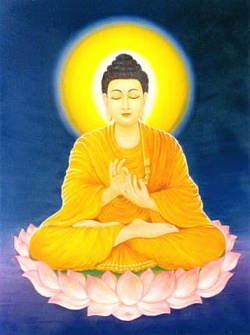Difference between revisions of "History of the Buddha's Successors"
| Line 2: | Line 2: | ||
<poem> | <poem> | ||
'''History of the [[Buddha's]] Successors''', A | '''History of the [[Buddha's]] Successors''', A | ||
| − | [付法蔵因縁伝] ([[Chin]] Fu-fa-tsang-yin-yüan-chuan; Jpn Fuhozo-innen- | + | [[付法蔵因縁伝]] ([[Chin]] [[Fu-fa-tsang-yin-yüan-chuan]]; Jpn [[Fuhozo-innen-]]) |
| − | Also known as the [[Buddha's]] Successors [[Sutra]]. A record of the twenty-three [[monks]] in [[India]] said to have [[successively]] inherited [[Shakyamuni]] [[Buddha's teachings]] and propagated them. [[Kinkara]] ([[Chin | + | Also known as the [[Buddha's]] Successors [[Sutra]]. A record of the twenty-three [[monks]] in [[India]] said to have [[successively]] inherited [[Shakyamuni]] [[Buddha's teachings]] and propagated them. [[Kinkara]] ([[Chin Chi-ch'ieh-yeh]]) and [[T'an-yao]] produced the {{Wiki|Chinese}} translation of this work in 472. The [[Sanskrit]] text is not extant. According to this account, the [[Buddha]] first transferred his teachings to [[Mahakashyapa]], who in turn entrusted them to [[Ananda]]. |
| + | |||
| + | [[Ananda]] transferred the [[Buddha's teachings]] to [[Shanavasa]], who in turn transferred them to [[Upagupta]]. In this way, the teachings were passed down to [[Aryasimha]], the twenty-third and last successor. [[Aryasimha]] was beheaded by [[King]] [[Mirakutsu]] (Jpn; [[Sanskrit]] unknown) and the line of succession ceased. | ||
| + | |||
| + | According to A History of the [[Buddha's]] Successors, [[Ananda]] transferred the [[Buddha's teachings]] to not only [[Shanavasa]] but [[Madhyantika]] as well, who propagated them in [[Kashmir]] and [[Gandhara]]. | ||
| + | |||
| + | Because [[Shanavasa]] transmitted the [[Buddha's teachings]] inherited from [[Ananda]] to the fourth successor, [[Upagupta]], he is regarded as the third successor. | ||
| + | |||
| + | Based on this explanation, {{Wiki|Chang-an}} (561-632), [[T'ient'ai's]] [[disciple]] and successor, listed the twenty-three successors (not including [[Madhyantika]]) in his preface to [[T'ient'ai's]] Great [[Concentration]] and [[Insight]]. | ||
| + | |||
| + | He added that because [[Madhyantika]] and [[Shanavasa]] had both inherited the [[Buddha's teachings]] from [[Ananda]], if [[Madhyantika]] is included among the [[Buddha's]] succes-sors, they number twenty-four. | ||
| + | |||
| + | Thereafter the [[T'ient'ai]] school (and its {{Wiki|Japanese}} counterpart, the [[Tendai school]]) came to refer both to the twenty-three and the twenty-four successors. | ||
</poem> | </poem> | ||
{{R}} | {{R}} | ||
Latest revision as of 19:04, 22 February 2015
History of the Buddha's Successors, A
付法蔵因縁伝 (Chin Fu-fa-tsang-yin-yüan-chuan; Jpn Fuhozo-innen-)
Also known as the Buddha's Successors Sutra. A record of the twenty-three monks in India said to have successively inherited Shakyamuni Buddha's teachings and propagated them. Kinkara (Chin Chi-ch'ieh-yeh) and T'an-yao produced the Chinese translation of this work in 472. The Sanskrit text is not extant. According to this account, the Buddha first transferred his teachings to Mahakashyapa, who in turn entrusted them to Ananda.
Ananda transferred the Buddha's teachings to Shanavasa, who in turn transferred them to Upagupta. In this way, the teachings were passed down to Aryasimha, the twenty-third and last successor. Aryasimha was beheaded by King Mirakutsu (Jpn; Sanskrit unknown) and the line of succession ceased.
According to A History of the Buddha's Successors, Ananda transferred the Buddha's teachings to not only Shanavasa but Madhyantika as well, who propagated them in Kashmir and Gandhara.
Because Shanavasa transmitted the Buddha's teachings inherited from Ananda to the fourth successor, Upagupta, he is regarded as the third successor.
Based on this explanation, Chang-an (561-632), T'ient'ai's disciple and successor, listed the twenty-three successors (not including Madhyantika) in his preface to T'ient'ai's Great Concentration and Insight.
He added that because Madhyantika and Shanavasa had both inherited the Buddha's teachings from Ananda, if Madhyantika is included among the Buddha's succes-sors, they number twenty-four.
Thereafter the T'ient'ai school (and its Japanese counterpart, the Tendai school) came to refer both to the twenty-three and the twenty-four successors.
